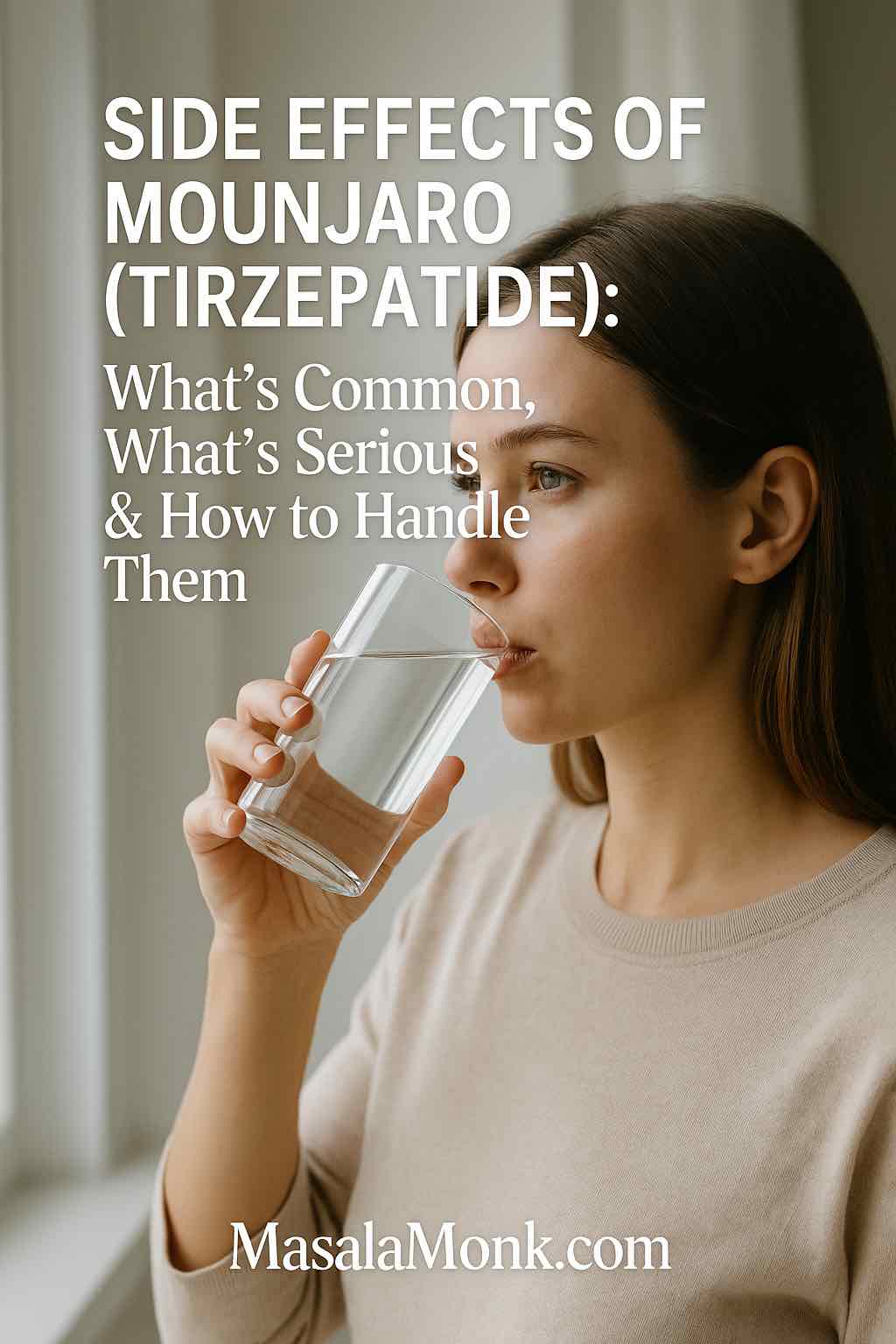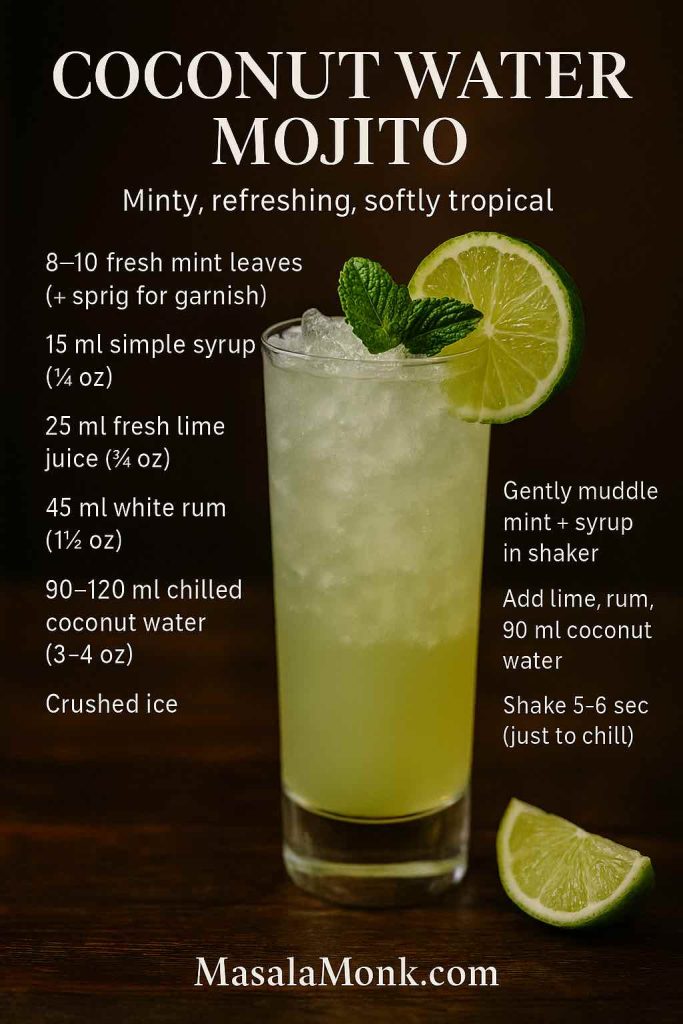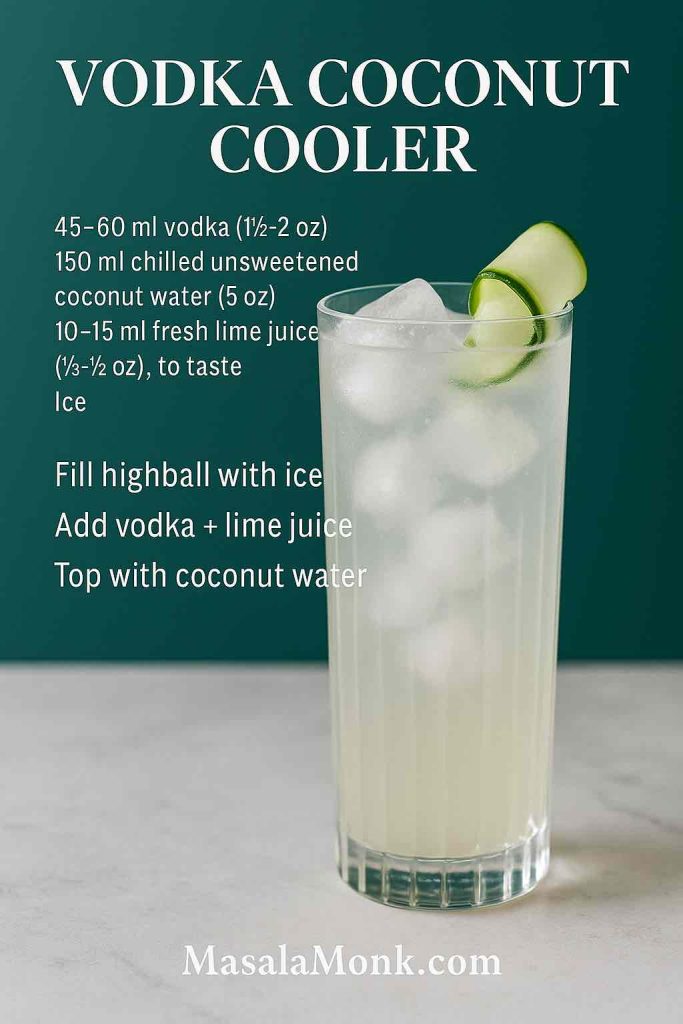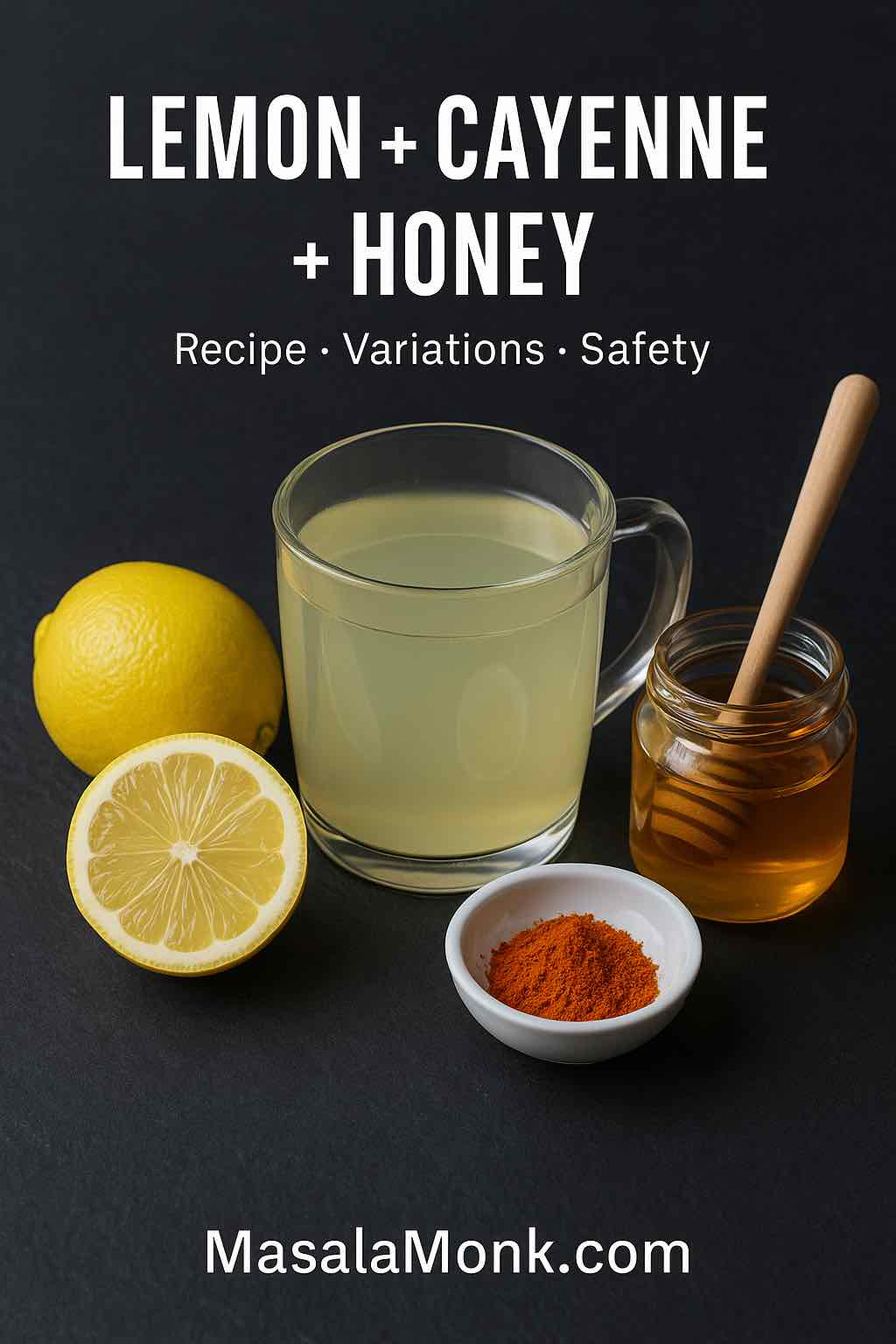
Some mornings ask for something simple, warm, and a little zippy. That’s where lemon, cayenne, and honey shine. This drink isn’t a miracle cure—your liver and kidneys already handle detoxing—but it can absolutely be a comforting ritual that supports hydration, brings a citrusy lift of vitamin C, and adds a gentle, invigorating heat from cayenne. Because people often arrive with very specific questions, we’ll walk through the benefits of lemon and cayenne pepper, share a two-minute recipe, explore smart variations (ginger, apple cider vinegar, and the maple-syrup version), and finish with realistic safety tips so the habit stays friendly.
Quick Take: The Real Benefits of Lemon and Cayenne Pepper
First, let’s set expectations in plain language. Most of the feel-good effect comes from hydration; starting your day with fluid is an underrated win. Meanwhile, lemon contributes vitamin C—a water-soluble nutrient you need regularly (see Harvard’s Nutrition Source on vitamin C and Harvard Health’s explainer).
Next, cayenne’s warmth comes from capsaicin. Research suggests small, short-term bumps in thermogenesis and energy expenditure; think of it as a gentle assist rather than a dramatic change (skim this broad umbrella review on spicy foods and a focused paper on capsaicin and body weight).
Finally, honey smooths acidity and spice, making the habit easier to enjoy consistently. It does add antioxidants, yet it’s still added sugar, so a measured teaspoon is plenty. And importantly, never give honey to infants under 12 months—the CDC’s guidance on infant botulism is crystal clear.
Because this drink is often lumped into “detox” talk, it helps to keep perspective. If you’d like a balanced view on cleanse claims, start with Harvard Health on detox cleanses and this general look at detox diets. Afterwards, if you want to compare rituals, you can also read our plain-spoken, in-house overview of the Master Cleanse for Detox and how it differs from an everyday beverage.
Evidence-Aware Benefits of Lemon and Cayenne Pepper (and Honey)
Lemon Water with Cayenne Benefits: Hydration First, Vitamin C Next
To begin with, the biggest, most reliable win is drinking more water. That alone can help you feel sharper and more energized. On top of that, lemon adds vitamin C, which supports normal immune function and helps with iron absorption. Because it’s water-soluble, a little each day works well—and a citrusy drink simply makes “a little each day” easier to do.
If you’re torn between warm or cold, choose the version you’ll actually drink. For gentle routines, many people like a mug of warm lemon water in the morning; for hot afternoons, others prefer the crisp feel of cold lemon water. Either way, you’re hydrating, and that’s the main win.
Cayenne Pepper, Lemon and Honey Benefits: A Gentle Thermogenic Nudge
Meanwhile, the spice note from cayenne can feel naturally stimulating. Mechanistically, capsaicin seems to nudge energy expenditure and fat oxidation modestly. However, it’s not a magic switch; your best results still come from an overall routine—protein, fiber, movement, and sleep—while this drink adds a small assist and a pleasant ritual. In other words, let the warmth help you start the day well, then let food and movement do the deeper work.
Honey’s Role: Flavor, Mouthfeel, and Consistency
Next up, honey. A teaspoon rounds off the edges so the drink feels balanced rather than sharp. That matters because a habit you enjoy is a habit you keep. Still, because honey is added sugar, consider it a flavor accent, not a requirement. If you’re sharing sips with family, remember: no honey for infants under one.
How To Make Lemon–Honey–Cayenne Water (2 Minutes)
Ingredients (1 serving)
- 250–300 ml warm water
- Juice of ½–1 lemon (to taste)
- ⅛ teaspoon cayenne pepper (start low; increase slowly)
- 1 teaspoon honey (optional)
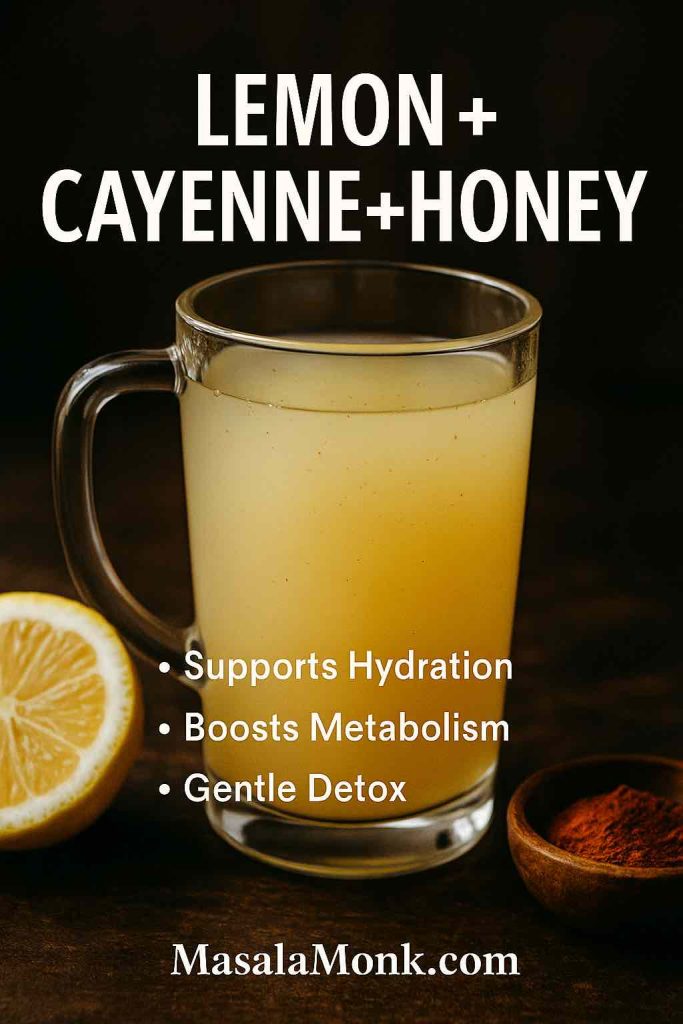
Method
- Stir lemon juice into warm water.
- Whisk in cayenne until dispersed.
- Add honey, stir, and sip while warm—or shake with ice if you prefer it cold.
Make-it-yours tips
- If you’re spice-sensitive, begin with a pinch of cayenne and build up over a week.
- If you love a brighter, crisper profile, make it iced by shaking with ice and straining.
- If you care about tooth enamel, remember that acidic drinks can contribute to erosion when sipped for long periods. Therefore, sip (don’t swish), rinse with plain water afterward, and give it a bit of time before brushing. Practical overview: American Dental Association on erosive tooth wear.
Variations Readers Actually Use (Flavor First, Hype Last)
Because everyone tweaks this drink, here are three popular riffs. Each keeps the core intact while changing the flavor or mouthfeel, and each still aligns with the overall benefits of lemon and cayenne pepper story.
Variation 1 — Lemon Cayenne Honey Drink with Ginger
If you want a cosier, aromatic kick, grate ½–1 tsp fresh ginger into the mug (or steep a thin slice for 3–5 minutes and remove). Ginger is well-known for easing certain kinds of nausea (including pregnancy-related), and it pairs beautifully with citrus and gentle heat. For a level-headed overview of usefulness and safety, see NCCIH on ginger.
If you’d like more ways to use it at home, our round-up of ginger drinks has easy combinations you can try this week.
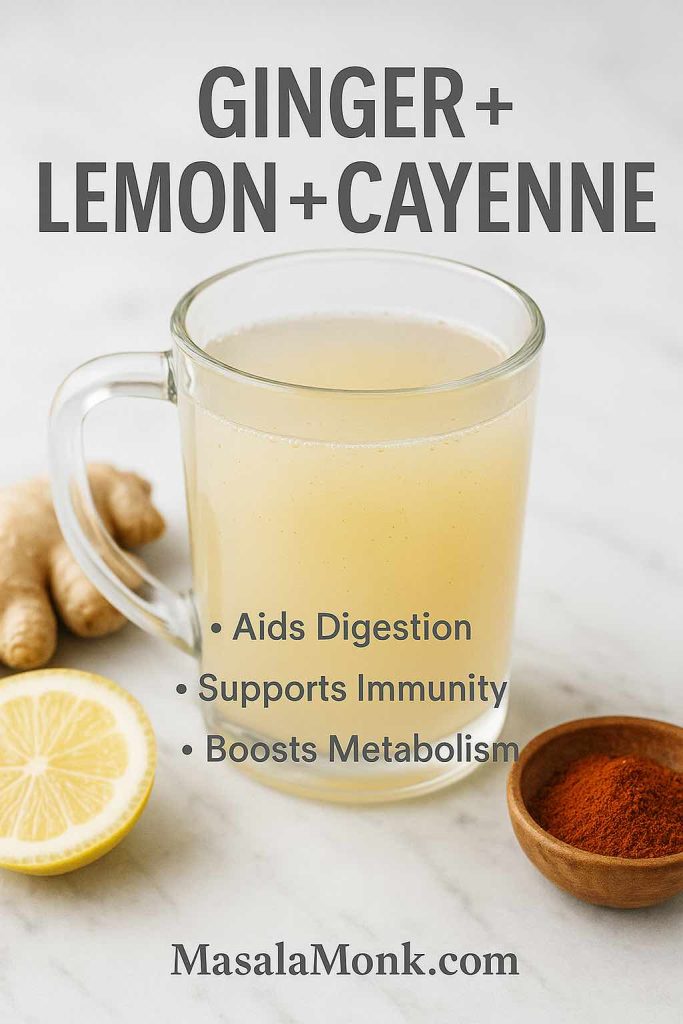
Flavor note: If you want ginger to lead, steep it first, then add lemon and cayenne at the end so the citrus stays bright and the spice stays crisp.
Variation 2 — Lemon and Cayenne Pepper Water with Apple Cider Vinegar (ACV)
For a sharper, tangier sip, add 1–2 teaspoons ACV to the base recipe and dilute well. The lemon keeps the drink bright, while cayenne adds warmth behind the vinegar’s tang. Because ACV is acidic, it can aggravate reflux and, over time, contribute to enamel erosion; rinsing with water afterward is a good habit. For what the evidence really says (and realistic amounts people use), see Harvard Health on ACV.
Prefer to eat your vinegar? Try one of our simple ACV salad dressing recipes and let flavor do the heavy lifting at mealtime.
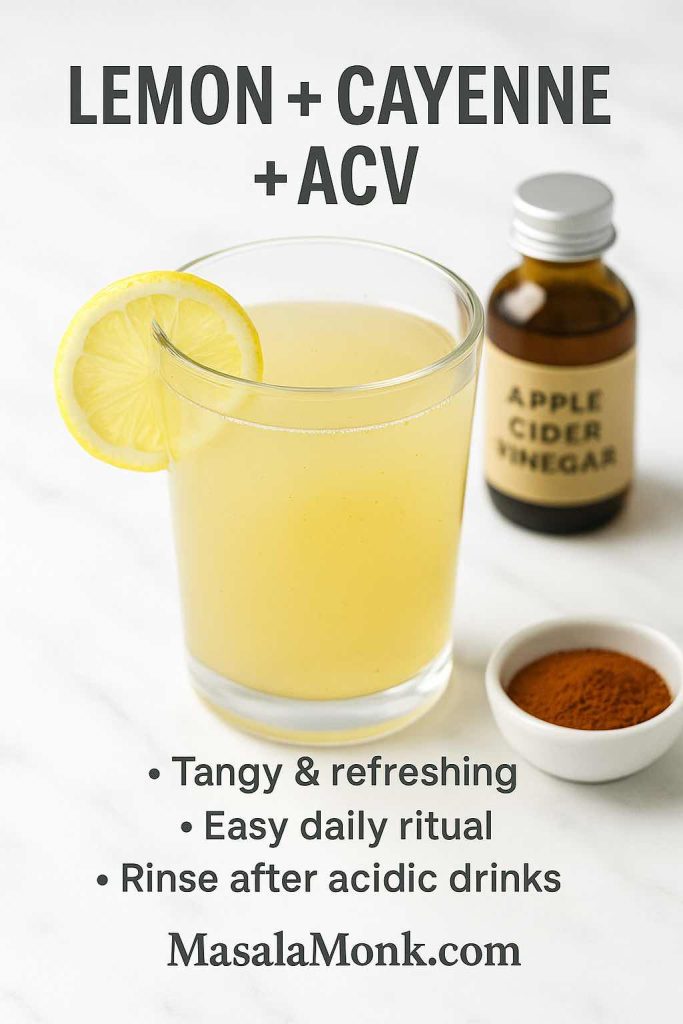
Pro tip: If lemon + ACV feels too intense, halve the lemon and go lighter on cayenne. Balance is everything.
Variation 3 — Lemon Cayenne “Cleanse” (the Maple Syrup Version)
This is the famous water-lemon-maple-cayenne combination, often used as a short fast. As a multi-day plan, it’s not nutritionally balanced and generally not recommended. If you’re simply curious about the taste, add 1–2 teaspoons maple syrup to the everyday recipe and stop there. For a straightforward overview, see WebMD’s Master Cleanse explainer.
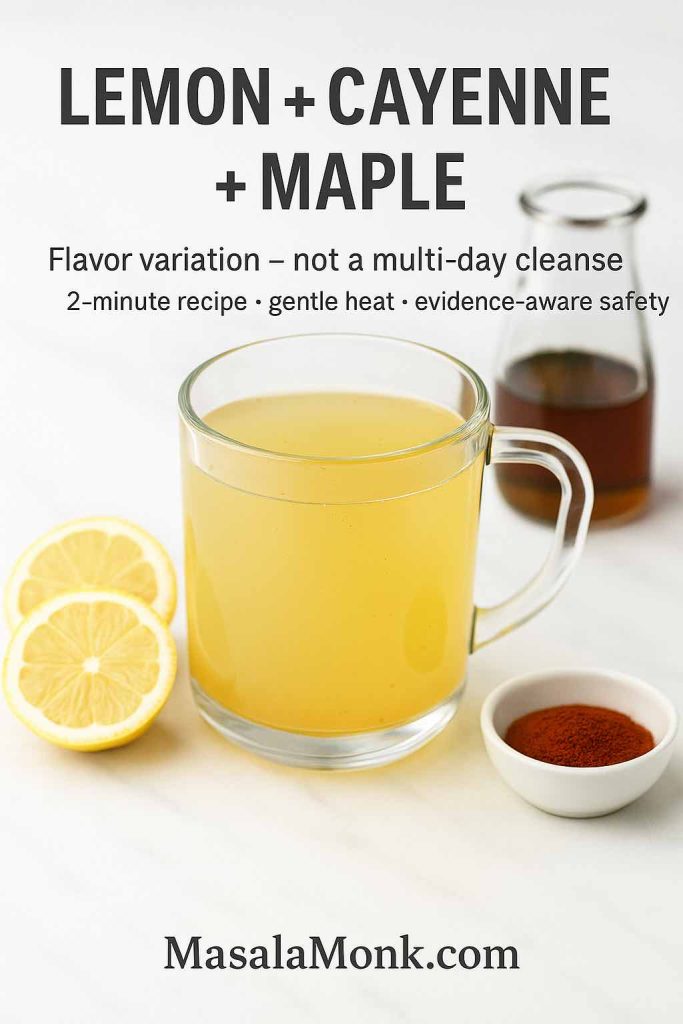
If you still want to understand how the cleanse compares to a daily beverage, our in-house overview—Master Cleanse for Detox—lays out the differences without the hype.
When To Drink It, How Often, and Small Tweaks That Matter
Now, let’s make this habit sustainable.
- Timing: Many people like it first thing in the morning because it’s soothing and hydrating. However, if you’re acid-sensitive, try it with breakfast instead.
- How much: One mug a day is plenty. More isn’t better; it’s still acidic, and honey or maple are still sugars.
- Sweetness dial: Keep honey to ~1 teaspoon or skip it. If you switch to maple syrup, start with less—it tastes slightly sweeter per teaspoon.
- Spice dial: You can move from a pinch to ⅛ teaspoon, and eventually to ¼ teaspoon if you love heat. Increase gradually and listen to your gut.
- Temperature choice: Warm feels cosy and morning-friendly; iced feels bright and afternoon-friendly. Pick what keeps you consistent.
And if you enjoy the citrus theme, you may also like exploring how lemon and lime water compare in everyday life—our round-up on lemon vs lime water is a quick, practical read.
Safety Snapshot (So This Stays Friendly)
- Infants: Absolutely no honey under 12 months (risk of infant botulism). See the CDC’s prevention page.
- Stomach/GERD/ulcers: Lemon’s acid plus capsaicin’s heat can irritate sensitive stomachs. Therefore, dilute more, go gentler on cayenne, and consider having it with food.
- Teeth: Acidic beverages can erode enamel with prolonged sipping. So, sip, rinse, and wait before brushing. Read more at the American Dental Association.
- Weight expectations: The benefits of lemon and cayenne pepper are supportive, not transformative. Capsaicin’s effect is modest; lasting change comes from overall diet quality, protein, fiber, movement, and sleep. If you’re curious about the research, see capsaicin & body weight and the spicy-foods umbrella review.
- Allergies & meds: If you have citrus sensitivities, mouth ulcers, or you’re on GI-sensitive medications, start mild and check with a clinician if unsure.
A Few Helpful Next Reads
- Master Cleanse for Detox (clear, balanced overview):
https://masalamonk.com/master-cleanse-for-detox/ - Warm lemon water in the morning (gentle routine):
https://masalamonk.com/the-morning-ritual-benefits-of-drinking-warm-lemon-water-every-morning/ - Cold lemon water (crisp, summer-friendly):
https://masalamonk.com/benefits-of-cold-lemon-water-refreshing-hydration-with-a-citrus-twist/ - Ginger drinks to try (comforting add-ons):
https://masalamonk.com/7-ginger-drinks-for-weight-loss-and-well-being/ - ACV salad dressing recipes (food-first vinegar ideas):
https://masalamonk.com/5-apple-cider-vinegar-dressing-recipes-for-expectant-mothers/
Final thought
In the end, the biggest benefits of lemon and cayenne pepper come from a very human place: small habits that feel good are the ones we actually keep. A warm (or iced) citrus-and-spice mug can mark the start of your day, nudge you to hydrate, and invite you to take the next right step—whether that’s a balanced breakfast, a short walk, or a calmer pace. Keep it simple, keep it kind, and let the ritual do its quiet work.
FAQs
1) What are the real benefits of lemon and cayenne pepper (with honey)?
In short, the benefits of lemon and cayenne pepper are mostly practical: hydration from the water, a gentle boost from vitamin C in lemon, and a mild thermogenic nudge from cayenne’s capsaicin. Honey can make the drink smoother and easier to stick with as a daily ritual. However, it’s supportive rather than miraculous—use it alongside balanced meals, sleep, and movement.
2) Does lemon water with cayenne pepper actually “detox” the body?
Not exactly. Your liver and kidneys already handle detox 24/7. So, while lemon water with cayenne benefits include hydration, flavor, and a cozy warm-up, the drink itself doesn’t remove toxins. Instead, think of it as a pleasant habit that nudges you toward better daily choices.
3) How do I make a quick lemon–honey–cayenne detox drink?
Start simple: warm water, juice of ½–1 lemon, ⅛ teaspoon cayenne (or just a pinch at first), and 1 teaspoon honey if you like. Stir and sip. For an iced version, shake with ice and strain. This covers “how to make lemon honey–cayenne pepper detox drink” while keeping it realistic and gentle.
4) What’s the best time to drink it—morning or evening?
Because it’s warming and hydrating, many people enjoy it first thing in the morning. That said, if acidity bothers you on an empty stomach, consider sipping it with breakfast. In the evening, keep the cayenne light so it feels soothing rather than too stimulating.
5) How much cayenne should I use if I’m new to it?
Begin with a tiny pinch—less than ⅛ teaspoon—and notice how you feel. Then, over a few days, ease up to ⅛ teaspoon. If you genuinely love heat, you can work toward ¼ teaspoon, but there’s no prize for going hotter. Consistency matters more than intensity.
6) Are there benefits of lemon and cayenne pepper without honey?
Absolutely. The core benefits of lemon and cayenne pepper—hydration, vitamin C, and gentle warmth—don’t require honey. Honey is mainly for taste and mouthfeel, so if you’re managing sugars, simply skip it or reduce the amount.
7) What about cayenne pepper, lemon, and honey benefits for weight loss?
Here’s the balanced view: cayenne’s thermogenic effect is modest. Therefore, the trio can support a healthy routine by making hydration enjoyable and signaling a “fresh start” to the day. Still, lasting weight change comes from overall habits—protein, fiber, steps, strength, and sleep.
8) Is the lemon cayenne cleanse (with maple syrup) a good idea?
As a long cleanse, it’s not ideal—too low in protein and fiber. However, as a flavor variation of your usual drink, a small splash of maple syrup is fine now and then. In other words, enjoy the taste, but avoid turning it into a multi-day fast.
9) Can I add ginger—and if so, why would I?
Yes, and it’s delicious. Grate ½–1 teaspoon of fresh ginger or steep a thin slice, then finish with lemon and cayenne. As a result, you get a deeper, spicier profile. Many people find ginger comforting, especially on cooler mornings.
10) What about apple cider vinegar with lemon and cayenne?
You can add 1–2 teaspoons for a tangier sip. Nevertheless, go slowly: the added acidity can feel strong. If reflux or enamel sensitivity is a concern, dilute more, sip rather than swish, and rinse your mouth with plain water afterward.
11) Warm or cold—does temperature change the benefits?
Not really. The primary lemon cayenne benefits come from hydration, vitamin C, and gentle spice—all of which you’ll get whether it’s warm or iced. So, choose the version you’ll happily drink today and tomorrow.
12) Who should be cautious with lemon and cayenne pepper water?
If you have reflux, active mouth ulcers, or a very sensitive stomach, start gently or have the drink with food. And importantly, never serve honey to infants under 12 months. When in doubt, go lighter, dilute more, and listen to your body.
13) Will this help my skin or immunity?
Indirectly, yes—by encouraging hydration and adding a small bump of vitamin C. But to be clear, glowing skin and resilient immunity depend on many factors: sleep, protein, colorful produce, and stress management. This drink can fit into that bigger picture.
14) How often should I drink it for best results?
Once a day is plenty for most people. More doesn’t necessarily mean better—especially since it’s acidic and, if sweetened, contains added sugar. Remember, the biggest benefits of lemon and cayenne pepper show up when the habit is consistent and comfortable.
15) Can I prep a batch in advance?
You can prep components. For the freshest flavor, squeeze lemon close to drinking time, or refrigerate lemon water for a few hours max. As for cayenne, it disperses better when freshly stirred. If you’re rushing, premix the dry cayenne with a spoon of honey so it blends faster later.
16) Does using bottled lemon juice change the benefits?
Fresh lemon tends to taste brighter, yet bottled is convenient. If you use bottled, choose one with lemon juice as the only ingredient and adjust to taste. Ultimately, the habit you’ll keep—fresh or bottled—is the one that brings you the most day-to-day benefit.
17) Can I swap honey for maple syrup or skip sweetness entirely?
Yes on both counts. Maple syrup brings a rounder sweetness, but it’s still sugar; use sparingly. Or, for an unsweetened version, lean on the citrus and spice alone. Many people find that, over time, their palate naturally adjusts to less sweetness.
18) Will lemon and cayenne water hurt my teeth?
Acidic drinks can wear enamel if you sip for long periods. Therefore, enjoy your mug, avoid swishing, and then rinse your mouth with water. Waiting a bit before brushing helps, too. Small, simple habits like these keep the ritual teeth-friendly.
19) Can I drink it before a workout?
You can. The warm spice and light hydration can feel motivating. Still, if you’re training hard, you may want a bit of protein or carbs as well. Try the drink 20–30 minutes before and see how your stomach feels, then adjust the cayenne up or down.
20) What’s the biggest mistake people make with this drink?
Going too strong, too soon. Instead, start with a pinch of cayenne, a moderate squeeze of lemon, and a teaspoon of honey (or none). Then, gradually adjust. When the routine feels kind and sustainable, the benefits of lemon and cayenne pepper naturally add up over time.

